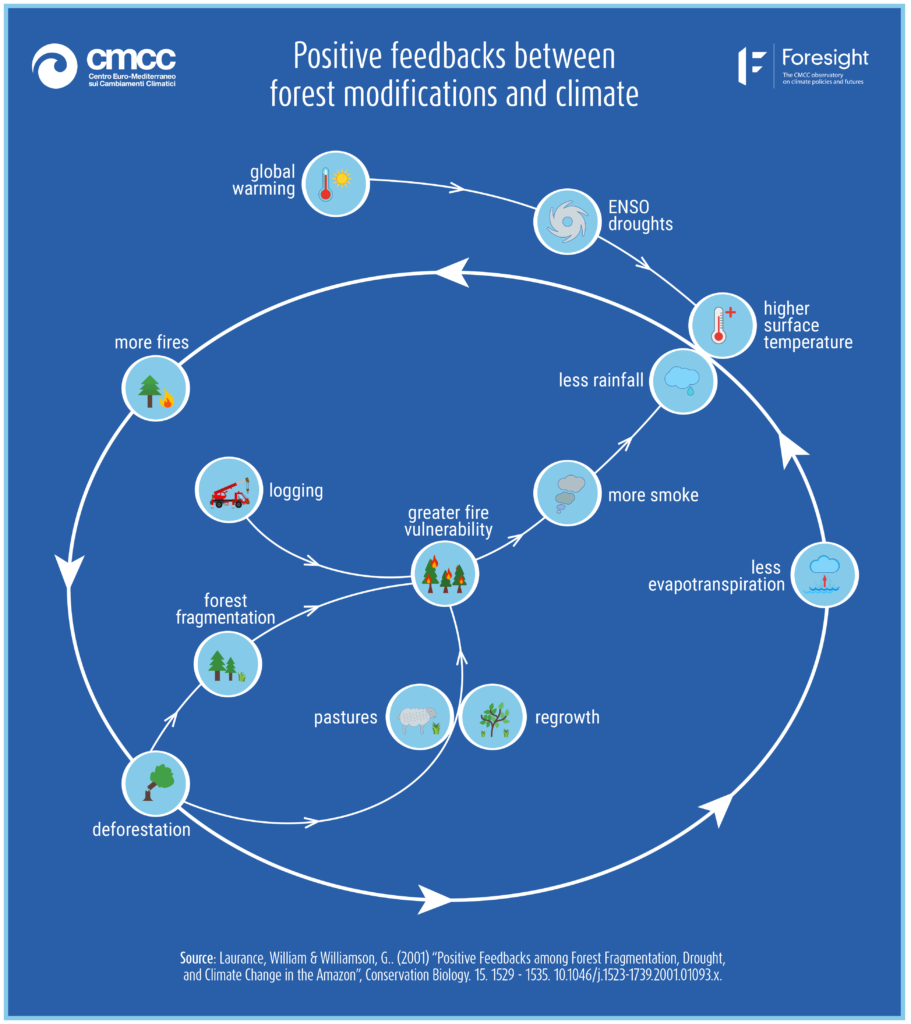Virus spillovers, CO2 emissions, tipping points in the Earth’s climate system, and the One Health approach: exploring the forest-climate-health nexus and how limiting forest fragmentation in the tropics can act as a multiplier of benefits.

One Health: words that are popping up in many articles, op-eds and commentaries concerning the Covid-19 outbreak and the link between increased deforestation, virus spillovers, and zoonotic diseases. In synthesis, One Health means that people’s health is closely linked to the health of animals, and our shared environment. This approach is also used to study how anthropized environments have an attractive effect on bats, as they meet their roosting and hunting needs, which comes with a major risk factor in the emergence of novel bat-borne diseases in both humans and animals. Particularly CoVs, which currently represent around 35% of bat-borne viruses. In this context, it is strategic to prioritize the development of therapeutic options and vaccines whilst also working on education, and raising awareness regarding the multiple risks associated with anthropized environments, as well as the multiple benefits that can arise from the One Health concept.
Forests as a mosaic: fragmentation and virus outbreaks
Not only does the cumulative amount of deforestation matter but the spatial patterns of forest loss are also critical. Fragmentation creates a complex mosaic of non-contiguous forested patches separated by deforested corridors/areas which increases the interaction between wild and anthropized systems.
High-resolution forest cover data from satellites is useful to study landscapes and demonstrate how the areas where the first Ebola virus disease outbreaks took place, in Africa from 2004 to 2015, were also hotspots of forest fragmentation and enhanced the probability of contact between humans and infection reservoirs, such as some frugivorous and insectivorous bat species.
In the last decade of the 20th Century, blocks of forests in Amazonia which were either fragmented (<100 km2) or prone to edge (< 1 km from the nearest clearing) were 150% larger than deforested areas, bringing the total “altered” area from 14% due to sole deforestation to around 35% if including fragmentation and the related ecological alterations that are called edge effects. Despite reductions in overall deforestation rates in the Amazon region in the last 20 years, approximately 11% of the forest area consists of forest fragments smaller than 10,000 ha and close to the critical threshold of fragmentation, i.e. carrying the risk of enhancing feedback mechanisms and triggering one of the tipping points in the Earth’s climate system.
The Amazon rainforest is not a one-off. In Africa and Asia-Australia critical conditions of fragmentation also exist, with fragments smaller than 10,000 ha close to 10% and 9%, respectively. Globally, it is estimated that around 19% (between 16%-18% in America and Asia, and 26% in Africa – with one fourth in the Congo basin) of the remaining area of tropical forests lies within 100 mt. of a forest edge, and 70% within 1 km. Globally, 50 million forest fragments (each with 29 ha of surface on average) create a forest/non-forest interface of ca. 50 million km. Additionally, 84% of the edge area is anthropogenically created (95% in Asia, 63% in Africa and 83% in America) and around 20% (comparable among regions) is due to corridor-like clear cuts (e.g. roads). In this context, progressively smaller and isolated fragments are more prone to disappear than larger patches due to easier access and exploitation.
Environment and climate: big consequences of smaller fragments
Besides the risks of spillovers and zoonosis, by facilitating human to wildlife contact, forest fragmentation produces multiple interlinked effects on the environment, reducing biodiversity by 13% to 75%, decreasing forest biomass, altering nutrient cycling, weakening the microclimate buffering effect of tropical forests, and more in general threatening ecosystem services (including climate regulation) and their flow to people.
A recent study published in the Journal Nature Communications, concluded that, considering a lag of 30 years for newly created forest edges to reach a new post-disturbance equilibrium, carbon emission of forest edges represent 31% of emissions (0.34 Gt/yr) due to tropical deforestation and 8.5% of the overall annual atmospheric carbon gain. The global distribution of carbon losses from tropical forest fragmentation finds Central and South America to have the highest contribution from forest edges with respect to deforestation areas (55%), followed by Asia (48%), which is favored by topography and small-scale fragmentation, and then Africa (17%). In particular, carbon loss estimates are higher for smaller fragments.
Tropical forest fragmented blocks and edges create additional feedback within the climate-drought-fire nexus. For example, tree mortality increases after droughts as well as the flammability of debris due to more sunlight passing through less dense canopies and because of either accidental or purposeful ignitions. In turn, these groundfires can further thin the canopies with new debris accumulation favoring successive larger fires. While debris decomposition and fueling is a direct source of carbon emissions, drought-reduced plant productivity (due to lowering of soil moisture) and plant respiration increase (due to rising temperatures) also enhance emissions. This is why fragmented forests are more prone to switching from being carbon sinks to sources of carbon emissions during periods of drought, especially in the case of El Niño, as happened in 2016 when vegetation loss from fragmented patches was higher than the mean for 2011-2018.
Furthermore, carbon stock in tropical forests can be overestimated by around 10% in carbon accounting systems, if they fail to consider that biomass is between 10 and 25% lower within 1500 and 500 m from the forest edges, thus hindering the possibility of designing effective forest and climate policies.
Besides the influence of tropical forest fragmentation on global warming through the carbon cycle, more regional climate impacts have been recognized due to reduced evapotranspiration efficiency and surface roughness, with a consequent reduction in rainfall due to missed moisture recycling. Moreover, fire smoke can reduce rainfall by trapping moisture and inhibiting droplet formation/increase.
All of which highlights how forest restoration, as well as rigorous actions to counteract the uncontrolled devastation of forest landscapes, can create a virtuous cycle of benefits for the environment in general, by ensuring the provision of key ecosystem services – as local to global climate regulation – to nature and people, and hence human systems, by reducing their exposure and vulnerability to epidemics and to cascading social and economic crises.
Refererences
- One Health Basics
- Afelt A, Frutos R and Devaux C (2018) Bats, Coronaviruses, and Deforestation: Toward the Emergence of Novel Infectious Diseases? Front. Microbiol. 9:702. doi: 10.3389/fmicb.2018.00702
- Rulli, M., Santini, M., Hayman, D. et al. The nexus between forest fragmentation in Africa and Ebola virus disease outbreaks. Sci Rep 7, 41613 (2017). https://doi.org/10.1038/srep41613
- William F. Laurance, G. Bruce Williamson, Positive Feedbacks among Forest Fragmentation, Drought, and Climate Change in the Amazon, https://doi.org/10.1046/j.1523-1739.2001.01093.x
- Taubert, F., Fischer, R., Groeneveld, J. et al. Global patterns of tropical forest fragmentation. Nature 554, 519–522 (2018). https://doi.org/10.1038/nature25508
-
Timothy M. Lenton, Hermann Held, Elmar Kriegler, Jim W. Hall, Wolfgang Lucht, Stefan Rahmstorf, Hans Joachim Schellnhuber, Tipping elements in the Earth’s climate system, Proceedings of the National Academy of Sciences Feb 2008, 105 (6) 1786-1793; DOI: 10.1073/pnas.0705414105
- Saravia, L.A., Doyle, S.R. & Bond-Lamberty, B. Power laws and critical fragmentation in global forests. Sci Rep 8, 17766 (2018). https://doi.org/10.1038/s41598-018-36120-w
- Claude Gascon, G. Bruce Williamson, Gustavo A. B. da Fonseca, Receding Forest Edges and Vanishing Reserves, Science 26 May 2000: Vol. 288, Issue 5470, pp. 1356-1358, DOI: 10.1126/science.288.5470.1356
- Matthew C. Hansen, Lei Wang, Xiao-Peng Song, Alexandra Tyukavina, Svetlana Turubanova, Peter V. Potapov and Stephen V. Stehman, The fate of tropical forest fragments, Science Advances 11 Mar 2020: Vol. 6, no. 11, eaax8574, DOI: 10.1126/sciadv.aax8574
- Ewers RM, Banks-Leite C (2013) Fragmentation Impairs the Microclimate Buffering Effect of Tropical Forests. PLoS ONE 8(3): e58093. https://doi.org/10.1371/journal.pone.0058093
- Nick M. Haddad, Lars A. Brudvig, Jean Clobert, Kendi F. Davies, Andrew Gonzalez, Robert D. Holt, Thomas E. Lovejoy, Joseph O. Sexton, Mike P. Austin, Cathy D. Collins, William M. Cook, Ellen I. Damschen, Robert M. Ewers, Bryan L. Foster, Clinton N. Jenkins, Andrew J. King, William F. Laurance, Douglas J. Levey, Chris R. Margules, Brett A. Melbourne, A. O. Nicholls, John L. Orrock, Dan-Xia Song and John R. Townshend, Habitat fragmentation and its lasting impact on Earth’s ecosystems, Science Advances 20 Mar 2015: Vol. 1, no. 2, e1500052, DOI: 10.1126/sciadv.1500052
- Matthew G.E.Mitchell, Andrés F.Suarez-Castro, Maria Martinez-Harms, Martine Maron, Clive McAlpine, Kevin J.Gaston, Kasper Johansen, Jonathan R.Rhodes Reframing landscape fragmentation’s effects on ecosystem services, Trends in Ecology & Evolution, Volume 30, Issue 4, April 2015, Pages 190-198, https://doi.org/10.1016/j.tree.2015.01.011
- Pütz, S., Groeneveld, J., Henle, K. et al. Long-term carbon loss in fragmented Neotropical forests. Nat Commun 5, 5037 (2014). https://doi.org/10.1038/ncomms6037
- Chaplin-Kramer, R., Ramler, I., Sharp, R. et al. Degradation in carbon stocks near tropical forest edges. Nat Commun 6, 10158 (2015). https://doi.org/10.1038/ncomms10158
- Lucia Perugini, Luca Caporaso, Sergio Marconi, Alessandro Cescatti, Benjamin Quesada, Nathalie de Noblet-Ducoudré, Johanna I House and Almut Arneth, Biophysical effects on temperature and precipitation due to land cover change, Environmental Research Letters, Volume 12, Number 5
- Michael T. Coe, Toby R. Marthews, Marcos Heil Costa, David R. Galbraith, Nora L. Greenglass, Hewlley M. A. Imbuzeiro, Naomi M. Levine, Yadvinder Malhi, Paul R. Moorcroft, Michel Nobre Muza, Thomas L. Powell, Scott R. Saleska, Luis A. Solorzano and Jingfeng Wang, Deforestation and climate feedbacks threaten the ecological integrity of south–southeastern Amazonia, Philosophical Transactions of the Royal Society B: Biological SciencesVolume 368, Issue 1619, https://doi.org/10.1098/rstb.2012.0155
- Brinck, K., Fischer, R., Groeneveld, J. et al. High resolution analysis of tropical forest fragmentation and its impact on the global carbon cycle. Nat Commun 8, 14855 (2017). https://doi.org/10.1038/ncomms14855







